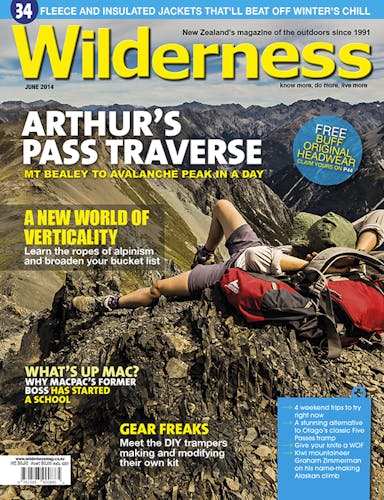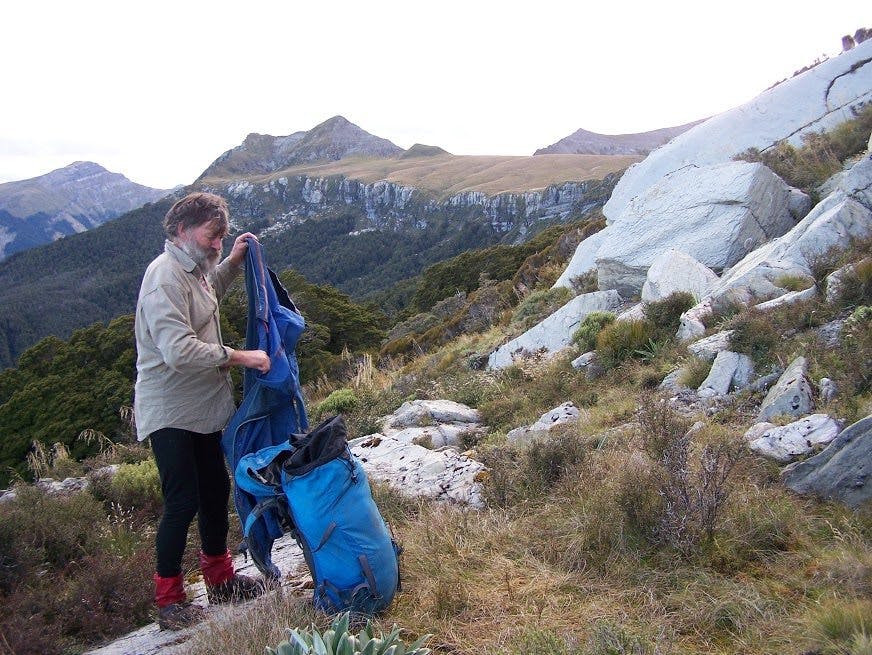Struggling to kit yourself out with all the latest tramping gear? Budget conscious Pete Lusk says it doesn’t need to cost you the earth
What does it cost to set up as a tramper? If you’re talking new gear, it could be as much as $3000 when you take boots, packs, sleeping bag, tent and other big ticket items into account. But I’ve got – and seen – some common-sense substitutions that will help keep your costs down.
Take rainwear for example. I’ve stayed away from $400 raincoats and kept my old one going. Yes it’s worn, yes it’s dirty, but when it gets ripped pushing through scrub I’m not worried.
I do own a nice Therm-a-Rest pad for sleeping and I don’t begrudge the $120 I paid for it. However, if I was poor and starting off, I’d make do with several layers of bubble wrap. It’s amazing how comfortable this can be, specially when you prepare your bed by digging hollows for your shoulder and hip. You can get the wrap free from your local whiteware or computer shop.
Recently I was tramping in Kahurangi National Park with my old hunting friend Jim Hilton. He has good gear, but none of it is new. For example, he still has one of the original Gore-Tex raincoats which he’s patched up with plasters to keep it more or less waterproof.
Jim doesn’t muck around with fancy foods. For an evening meal he boils up brown rice. If there’s any left over he’ll eat it for breakfast. During the day he takes a few mouthfuls of rolled oats followed by a big spoonful of brown sugar – basically a muesli bar without the wrapping.
Jim doesn’t bother with hot drinks. Why would you when the water in the creeks is so clear and refreshing?
Boots can be worn to within an inch of disintegrating by wrapping them with duct tape. Almost as good is New Zealand flax, one of the strongest fibres in the world.
It’s worth splashing out on new polyprop tops and bottoms. At sale time, a pair can be got for $30 or less. Shorts and jackets can be had from the op shops for a dollar or two.
Sleeping bags have the unusual quality of becoming lighter in weight as the quality and warmth increases. So buy a cheap one and start your tramping in the warmer months. In summer, I take my daughter’s Spiderman bag which she got from The Warehouse and which weighs only 900g. If it gets cold I put on all my clothes and drape a jacket over my shoulders. And don’t forget to wrap your head – it’s a major source of heat loss.
Most cooking stoves are bulky and require liquid or gas fuel which adds weight. A canny hunter mate uses cheap firelighter blocks in his cooker. They’re contained within a circle of stiff netting that sits on top of a perforated tuna can. I was impressed by the speed with which this contraption boils water. His firelighters are the brown ones that look like weetbix and blacken your billy. If you want to keep things clean, use the more expensive smokeless firelighters.
It’s worth splashing out on a good pair of gaiters, but if you can’t afford them, do what veteran tramper Kerry Silverwood does: wrap a narrow band of cloth around the top of your boots and secure with a cord – such cloth gaiters were the standard for Kiwi troops in the First World War.
But you don’t have to make getting by with cheap gear a lifelong habit. Upgrade your gear when you can afford it, buy yourself a decent pack, proper boots, gaiters that come on and off easily and nice colour-coordinated clothing.
There are times when everyone needs to splash out and what better way to lower that bank balance than with quality, new tramping gear?







